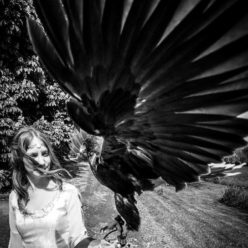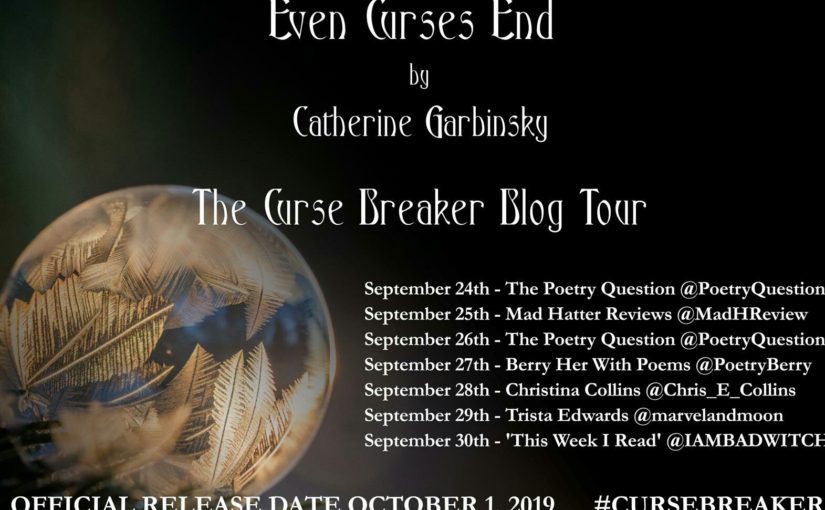Flicking through the titles of Garbinsky’s Even Curses End, I began by lunging for my copy of Angela Carter’s book of fairy tales before settling into the sofa reading joyfully from simultaneous piles of open books.
Garbinksy has opened the chest of the European tradition’s fairy tales and picked spools from the iconic to the obscure to weave her collection. Her choices remind us that the fairy tale was rarely princesses being rescued, but every day folk battling with a world too vicious to be believed real. Violence links these poems, and in the footsteps of great writers of the genre, she reminds us that envy, cruelty and blood were the fabric of these stories before Disney got hold of them.
Well, re-imaginings of fairy tales have been done. Garbinsky sets a different pattern in her loom by playing with narrative perspectives; merging them to trick our sympathies – is the character addressed in ‘Little Red’ the wolf or the eponymous girl? Is ‘The House on Chicken Legs’ a window to Baba Yaga or the innocent girl sent to her for light? In doing so, Garbinsky weaves what for me was most crucial; shining a light on the symbolic outcast/outsider figure and giving them a voice. The maligned and lonely witch is given the chance to tell of her ‘robin’s egg heart’ beneath the ‘crooked branches’ of her body; we weep with the beast dismayed that its solitude is lifted at last by someone who ‘did not flinch.’ And this I found poignant. Many a schoolchild has been called upon to use the fairy tale to learn empathy and kindness; to imagine the wolf hungry and alone. I felt Garbinsky went to the heart of the matter, recasting today’s marginalised that are feared and hated like beasts and witches; the homeless, the immigrant refugee, the man or woman of a different faith, into these timeless universal characters. To show us what we have in common.
Metamorphosis plays a huge part. Fairy tales have always centred on change, growth, sexual development and these poems can also stand for the metamorphosis of how fairy tales translate from the land of myth to the real world, as ‘The Grey’ seal woman shows us ordinary girls struggling in smothering relationships (in an extraordinarily structured poem that can be read differently downwards and sideways), and lazy girls justly punished by Mother Holle become those too crushed by depression to contribute in the world. Most importantly, many of these poems made me think of love, of human relationships and the transformation love can enact on us. My favourite poem ‘Loving What is Wild’ shows us that the Beast is just someone we don’t yet understand, who is as afraid of our anger and rejection as we are of its difference. The fear is dispelled by kindness; openness unravels the myth, and the curse ‘like an old rug/ Like a tapestry tugged at over years’ falls away and the beast is now a brother. In the perfectly named poem ‘Beauty,’ love redeems the beast, ‘a ritual of hope,’ showing us it is love’s beauty that transforms.
And from this acceptance, more grows. From love comes strength, power, solidarity. The poem ‘Seven Years of Silence’ offers a volta to the collection that gives it its name – a curse finally expires because even in fairy tales, they cannot last forever and the silenced protagonist now shouts ‘like church bells,’ to summon others to hear her herald change, redemption; liberation from trauma. Strength arises in ‘Healing is a Hiding Place;’ the abused Cinderella defiantly invites her persecutors: ‘Let them come. Let them see…I will not shatter,’ life’s traumas will eventually ‘crack…softly like an egg.’
The poem ‘What Desire Can Do’ stood for me as a symbol for the collection. The witch teaches Rapunzel to use ‘not my body, but my voice,’ – she becomes the poet with the tool that allows her to create a love that is beautiful and illuminating; that enriches instead of devours and crushes. Love that transcends hate and fear and transforms bears and beasts into humans, by giving them a voice. The resolution sought by fairy tales.
And life.
I don’t actually know if Catherine Garbinsky was aiming for some big metaphor about prejudice in society and the redemptive power of love – admittedly references to Islamophobia may have been a bit of a stretch. But when I read them – I was woven an image of the incredible potential of love to make a beast a man and give a witch her life back. And I liked that.

